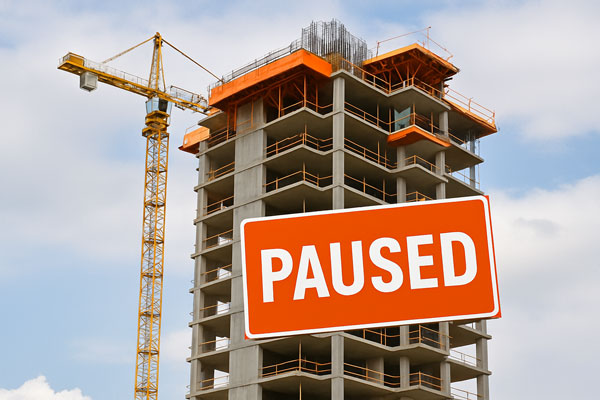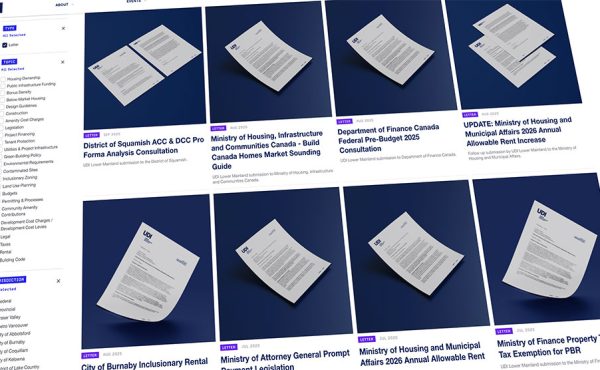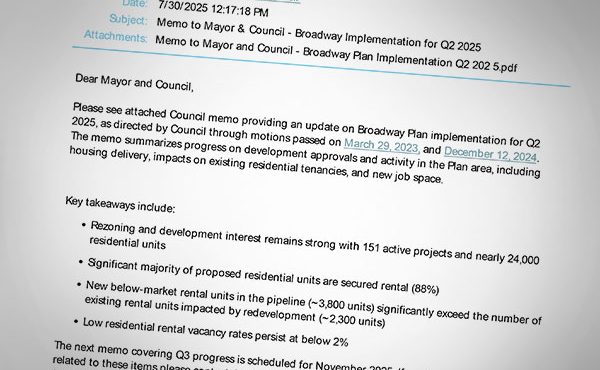
[Editor’s note: This letter, signed by 27 prominent B.C. experts in urban planning and architecture, was sent last week to Prime Minister Mark Carney and Minister of Housing Gregor Robertson, and was cc’d to, among others, B.C. Premier David Eby, B.C. Minister of Housing Christine Boyle and Vancouver Mayor Ken Sim. One can download the letter here.]
July 22, 2025
To: The Right Honourable Mark Carney, Prime Minister of Canada
The Honourable Gregor Robertson, MP, Federal Minister of Housing and Infrastructure
Re: Advancing Housing Affordability Through Bold, Evidence-Based Policy
We are a Metro Vancouver region-based group of urbanists, urban planners, architects, developers, and UBC/SFU academics, most with decades of experience, who have joined together to broaden the search for enduring housing solutions. While our primary focus is on Vancouver, our comments below are also applicable to cities across Canada that are also struggling with affordability issues.
Canada’s housing crisis demands a reset in how we use public policy to achieve affordability. The current market correction presents an opportunity—not a threat. Governments should not bail out speculative development models, but instead use this moment to invest in non-market housing, preserve existing affordability, and ensure that public subsidies serve long-term public outcomes.
1. Canada’s housing strategy must deliver affordability—not just more supply
Canada’s housing crisis is, above all, a crisis of affordability. Supply has increased significantly in cities like Vancouver—where housing starts have outpaced population growth for decades—yet prices remain disconnected from incomes.
Vancouver provides one of the most comprehensive real-world tests of this theory. Between 1960 and 2020, it increased its housing stock by over 200% while population grew by only 78%—more than any other North American central city. Yet its housing affordability declined dramatically, and it now has the highest home price-to-income ratio on the continent. (See attached Appendix A illustrations)
This data, drawn from Statistics Canada and U.S. Census sources, suggests that increasing housing density alone is insufficient to produce affordability. Without addressing land value inflation, financial speculation, and tenure security, supply-side interventions risk worsening the very crisis they aim to solve.
2. Use the market correction as an opportunity—not something to resist
- Do not use public funds to bail out overleveraged speculative developments.
- Do not reintroduce foreign capital or investor demand to reflate prices artificially.
- Take advantage of falling land costs and freed-up skilled labour to invest in non-profit, co-op, and public housing that will remain affordable long-term.
- Policy—not just construction—can influence affordability. Recent short-term rental regulations, adjusted immigration targets, and demand-side measures have already helped reduce pressure on rents.
3. Public subsidies must deliver public benefit outcomes
- Prioritize federal financing and grants for co-ops, land trusts, and nonprofits.
- Since CMHC-backed programs like MLI Select are not producing the right kind of supply that is affordable and livable, while it puts CMHC at undue risk, reconsider if more of CMHC resources should go towards co-op housing with permanent affordable housing instead.
- Require minimum livability standards, especially for family-friendly housing.
- Ensure affordability is defined relative to local incomes, not market medians, and is long term permanently secured through strong covenants and housing agreements.
4. Preserve what’s affordable—don’t displace it
- Make tenant protection and zero net-loss of affordable units, mostly through protecting existing rental buildings from demolition, a condition for accessing federal infrastructure or housing funds.
- Support rehabilitation and retrofits of existing rental buildings as climate-resilient, affordability- preserving alternatives to demolition.
- Recognize the human toll of displacement—the best tenant protections are to protect existing rental buildings.
- Ensure that public funds do not create the wrong kinds of supply that inflate land values and market rents, like CMHC’s MLI Select financing is currently doing, with the impacts on land values of tower development in particular.
5. Reform delivery and financing models to align with residents’ needs
- Provide tax, financing and policy incentives to encourage individual end-users to build more secondary suites and infill developments that can create both more rentals and mortgage helpers.
- Support gentle, ground-oriented density options that better match household needs and local context.
- Avoid making towers the default solution. Towers have their place—particularly in transit-rich areas— but they are not always the best form. The right supply is livable, secure, and suited to local neighbourhoods without triggering demovictions.
6. Rebalance costs and benefits between all orders of government
- The costs of growth—especially infrastructure and amenities—should not be downloaded to municipalities (i.e., local taxpayers and communities).
- Tie federal support to reforms that ensure new development pays its fair share for growth-related amenities, transit, and public services.
Conclusion
We encourage and support building more affordable, livable housing rather than continuing to build the wrong kinds of housing, in the wrong places, for the wrong reasons.
We believe the federal government can lead the way by restoring affordability as the central objective of housing policy. That means resisting short-term pressure to rescue flawed models and instead embracing long-term investment in public, non-profit, and community-led housing. It also means preserving existing affordability, and building new homes that serve real people, not just markets.
We welcome the opportunity to meet with you to explore how these strategies can shape a more sustainable and just housing future for all Canadians.
***
Cc:
Paul Halucha, Deputy Minister, Federal Ministry of Housing and Infrastructure Canada Honourable
David Eby, Premier of British Columbia
Honourable Christine Boyle, MLA, Minister of Housing and Municipal Affairs, BC
Teri Collins, Deputy Minister, Ministry of Housing and Municipal Affairs
Mayor Ken Sim and Council, City of Vancouver
*****
Signed:
David Ley, OC, FRSC, PhD, Urban Geographer, Professor Emeritus UBC, Order of Canada.
Christina DeMarco, Urban and Regional Planner, former lead planner for the Metro Vancouver Regional Growth Strategy.
Penny Gurstein, PhD, MCIP (ret.) Professor Emeritus and Former Director, School of Community and Regional Planning, Co-Director, Housing Research Collaborative, UBC
Larry Beasley, CM, FCIP, Former Co-chief Planner of Vancouver, author Vancouverism.
Patrick Condon, Professor UBC School of Landscape and Architecture, author Broken City. Former city planner, James Taylor Chair in Landscape and Liveable Environments.
Scot Hein, Retired Architect MAIBC/Former COV and UBC Senior Urban Designer and Development Planner/Adjunct Professor Urban Design UBC/SFU Faculty Continuing Studies/Founding Board Member Urbanarium/Board Member Small Housing BC/Housing Advocate
Brian Palmquist, award-winning architect and author, AIBC MRAIC BEP CP LEED AP
Arny Wise, B. Comm., M.Sc.(Planning) U of T, Professional Planner MCIP, RPP (retired), Board of Directors, Toronto Economic Development Corporation (1990-1999).
Sean McEwen, Architect, AIBC, FRAIC. Affordable housing advocate.
Barbara Gordon, Retired Architect AIBC and retired Director of Capital Planning, UBC
Lance Berelowitz, AA Dipl RPP MCIP, Principal Urban Forum Associates.
Michael Geller, FCIP, RPP, MLAI, Ret Architect AIBC, urban planner, real estate consultant, developer and Adjunct Professor, SFU.
Elizabeth Murphy, private sector project manager formerly with the City of Vancouver’s housing and properties department, BC Housing and BC Buildings Corp
Bill McCreery, BArch UMan; Sub Lt. RCNR, helped create North and South False Creek and thousands of units of developer & public housing in Vancouver.
Graham McGarva, FRAIC, Retired Architect AIBC, M.A.
Erick Villagomez, Lecturer, UBC School of Community and Regional Planning, Principal, Mētis Design|Build, Editor-in-Chief, Spacing Vancouver.
Norman Hotson, Retired Architect AIBC, FRAIC, RCA, HonPIBC.
Mary Pynenburg MRAIC (Retired) MCIP (Retired).
Robert Renger, BES, MCP; Consultant City Planner; Former Senior Development Planner and City’s lead for UniverCity at SFU, City of Burnaby.
Andy Yan, FCIP, RPP, GISP Director, City Program, Lifelong Learning and Associate Professor of Professional Practice, Urban Studies Program, Simon Fraser University.
Tom Phipps, Retired Senior Planner City of Vancouver (33 years)
Sandy James, former City of Vancouver City Planner, Managing Director, Walk Metro Vancouver.
Ralph Segal, MAIBC (ret.) Former Chief Urban Designer, City of Vancouver.
Elvin Wyly, PhD, Urban Geographer, Housing Researcher.
Mary Beth Rondeau, Ret Architect AIBC Former Urban Designer City of Vancouver
Frank Ducote, Principal, Frank Ducote Urban Design, former Senior Urban Designer, City of Vancouver
David Wong, Architect, AIBC; formerly with Engineering & Planning Dept. City of Vancouver
***
APPENDIX A
Notes and Illustrations
Illustration #1

Illustration #1 – This highlights Vancouver’s achievement compared to other North American central cities, showing that Vancouver increased its housing stock by 200%, despite only a 78% increase in population. Source: Patrick M. Condon and Thomas Kroeker, 2025
Illustration # 2

Illustration #2 – This shows how the ratio of housing prices to median household income has evolved over time (refer to Illustration #1 above). This chart reveals how Vancouver’s housing market has diverged from typical patterns in terms of residential density, housing affordability, and housing supply since 1960. Source: Patrick M. Condon and Thomas Kroeker, 2025
https://drive.google.com/file/d/1pwj80NJbJLopmtshJ5juL85_uRoRWLu4/view?usp=sharing
***





2 comments
Subject: Inclusion of Realtor Expertise in National Housing Solutions
We read with great interest the recent letter sent to Prime Minister Mark Carney and Minister of Housing Gregor Robertson, signed by many respected voices in urban planning, architecture, and housing policy. The collective commitment to advancing housing affordability is both encouraging and necessary.
However, one notable omission stood out: not a single representative from the real estate industry — not one licensed REALTOR® — was included among the signatories.
Given that REALTORS® are on the ground daily, directly engaging with homeowners, buyers, renters, developers, and communities, our perspective is critical to any serious national housing conversation. We witness market realities in real time, understand neighbourhood-level barriers, and can help bridge the gap between policy intent and on-the-ground implementation.
Through initiatives such as our I Invest in Housing campaign and our partnership with Greater Vancouver REALTORS®, Four Pillars Community Housing is actively mobilizing the real estate sector to accelerate the creation of new housing — particularly ADUs, multiplexes, and interim residences — while preserving existing rental stock. This work directly aligns with many of the priorities outlined in your letter, including increasing livable housing supply, protecting affordability, and fostering community-led solutions.
We believe the conversation about housing policy — especially one that aspires to be “bold” and “evidence-based” — must include the voices of those who are already operating in the market every day. By collaborating with REALTORS®, we can more effectively turn policy goals into tangible outcomes that work for residents, communities, and governments alike.
We would welcome the opportunity to meet with you and your colleagues to explore how the real estate industry can be more meaningfully engaged in the development and delivery of these solutions.
Sincerely,
Larry Traverence
Co-Founder, Four Pillars Community Housing
Vice President, Investment & Commercial Division, Dexter Realty
Joseph MacLean
Co-Founder, Four Pillars Community Housing
I want to sign this letter as well.
The issue of construction financing is one of the central issues in housing right now. Developers are holding pre-sale units off the market, outside of MLS, and they are ready to move in. Brand new, vacant housing. That the private sector can withhold supply from the market is an insult to market economics and prevents Canadians from finding the housing they need, where they need it, at the price they need it, right now.
Pre-sale rules must be re-worked. Have investors fund construction, not ownership. We don’t need condos 90% sold years before they are ready to live in, this system rewards investors, and in turn Developers cater to that class of buyer, not the people. In an affordability crisis this is a very large, remaining insult still to be addressed.
And remember generational sacrifice – we sent two generations of Canadians to Europe to fight wars over there. The idea that Canadians today can’t lose a bit of home equity to restore affordability is moral cowardice considering this is an affordability crisis affecting us right now, and every day, and in some cases it’s been going on for years. You want to think again on that intention to protect home equity (and therefore home prices) in the middle of a housing affordability crisis; this would constitute a two-tier society with specific housing perks, and it will not stand.
End the affordability crisis now.